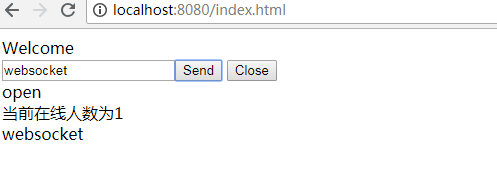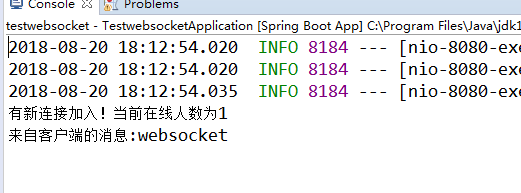随着互联网的发展,传统的HTTP协议已经很难满足Web应用日益复杂的需求了。近年来,随着HTML5的诞生,WebSocket协议被提出,它实现了浏览器与服务器的全双工通信,扩展了浏览器与服务端的通信功能,使服务端也能主动向客户端发送数据。
伴随着HTML5推出的WebSocket,真正实现了Web的实时通信,使B/S模式具备了C/S模式的实时通信能力。WebSocket的工作流程是这 样的:浏览器通过JavaScript向服务端发出建立WebSocket连接的请求,在WebSocket连接建立成功后,客户端和服务端就可以通过 TCP连接传输数据。因为WebSocket连接本质上是TCP连接,不需要每次传输都带上重复的头部数据,所以它的数据传输量比轮询和Comet技术小 了很多。本文不详细地介绍WebSocket规范,主要介绍下WebSocket在Java Web中的实现。
JavaEE 7中出了JSR-356:Java API for WebSocket规范。不少Web容器,如Tomcat,Nginx,Jetty等都支持WebSocket。Tomcat从7.0.27开始支持 WebSocket,已下内容基于tomcat 7.x的websocket实现,这种方式配置相对简单,但是对于不支持websocket的浏览器则不适用,如果想在不支持websocket的浏览器实现服务器端的消息推送,可参考我的另一篇博客https://www.cnblogs.com/hhhshct/p/8849449.html。
1、核心注解@ServerEndpoint,这是JavaEE 7标准里的注解,tomcat7以上已经对其进行了实现,如果是用传统方法使用tomcat发布项目,则需要我们在pom.xml引入对应的依赖。
<dependency>
<groupId>javax</groupId>
<artifactId>javaee-api</artifactId>
<version>7.0</version>
<scope>provided</scope>
</dependency>
springboot的内置tomcat时,就不需要引入javaee-api了,并且springboot为我们提供websocket的相关starter包,会自定配置一些基础组件,我们使用时只需引入以下依赖
<dependency>
<groupId>org.springframework.boot</groupId>
<artifactId>spring-boot-starter-websocket</artifactId>
</dependency>
2、首先要配置ServerEndpointExporter的实例到springboot容器中,这个bean会自动注册使用了@ServerEndpoint注解声明的Websocket endpoint为自己的子类
package com.example.demo; import org.springframework.context.annotation.Bean; import org.springframework.context.annotation.Configuration; import org.springframework.web.socket.server.standard.ServerEndpointExporter; @Configuration public class WebSocketConfig { @Bean public ServerEndpointExporter serverEndpointExporter() { return new ServerEndpointExporter(); } }
3、websocket的具体实现,需要通过注解的方式重写其各个方法,实现自定义的需求,虽然@Component默认是单例模式的,但springboot还是会为每个websocket连接初始化一个bean,所以可以用一个静态set保存起来。
package com.example.demo; import java.io.IOException; import java.util.concurrent.CopyOnWriteArraySet; import javax.websocket.OnClose; import javax.websocket.OnError; import javax.websocket.OnMessage; import javax.websocket.OnOpen; import javax.websocket.Session; import javax.websocket.server.ServerEndpoint; import org.springframework.stereotype.Component; @ServerEndpoint(value = "/websocket") @Component public class MyWebSocket { //静态变量,用来记录当前在线连接数。应该把它设计成线程安全的。 private static int onlineCount = 0; //concurrent包的线程安全Set,用来存放每个客户端对应的MyWebSocket对象。 private static CopyOnWriteArraySet<MyWebSocket> webSocketSet = new CopyOnWriteArraySet<MyWebSocket>(); //与某个客户端的连接会话,需要通过它来给客户端发送数据 private Session session; /** * 连接建立成功调用的方法*/ @OnOpen public void onOpen(Session session) { this.session = session; webSocketSet.add(this); //加入set中 addOnlineCount(); //在线数加1 System.out.println("有新连接加入!当前在线人数为" + getOnlineCount()); try { sendMessage("当前在线人数为" + getOnlineCount()); } catch (IOException e) { System.out.println("IO异常"); } } /** * 连接关闭调用的方法 */ @OnClose public void onClose() { webSocketSet.remove(this); //从set中删除 subOnlineCount(); //在线数减1 System.out.println("有一连接关闭!当前在线人数为" + getOnlineCount()); } /** * 收到客户端消息后调用的方法 * * @param message 客户端发送过来的消息*/ @OnMessage public void onMessage(String message, Session session) { System.out.println("来自客户端的消息:" + message); //群发消息 for (MyWebSocket item : webSocketSet) { try { item.sendMessage(message); } catch (IOException e) { e.printStackTrace(); } } } @OnError public void onError(Session session, Throwable error) { System.out.println("发生错误"); error.printStackTrace(); } public void sendMessage(String message) throws IOException { this.session.getBasicRemote().sendText(message); } /** * 群发自定义消息 * */ public static void sendInfo(String message) throws IOException { for (MyWebSocket item : webSocketSet) { try { item.sendMessage(message); } catch (IOException e) { continue; } } } public static synchronized int getOnlineCount() { return onlineCount; } public static synchronized void addOnlineCount() { MyWebSocket.onlineCount++; } public static synchronized void subOnlineCount() { MyWebSocket.onlineCount--; } }
4、前端代码,编写index.html放置到resource/static包下
<!DOCTYPE HTML> <html> <head> <title>My WebSocket</title> </head> <body> Welcome<br/> <input id="text" type="text" /><button onclick="send()">Send</button> <button onclick="closeWebSocket()">Close</button> <div id="message"> </div> </body> <script type="text/javascript"> var websocket = null; //判断当前浏览器是否支持WebSocket if('WebSocket' in window){ websocket = new WebSocket("ws://192.168.1.118:8080/websocket"); } else{ alert('Not support websocket') } //连接发生错误的回调方法 websocket.onerror = function(){ setMessageInnerHTML("error"); }; //连接成功建立的回调方法 websocket.onopen = function(event){ setMessageInnerHTML("open"); } //接收到消息的回调方法 websocket.onmessage = function(event){ setMessageInnerHTML(event.data); } //连接关闭的回调方法 websocket.onclose = function(){ setMessageInnerHTML("close"); } //监听窗口关闭事件,当窗口关闭时,主动去关闭websocket连接,防止连接还没断开就关闭窗口,server端会抛异常。 window.onbeforeunload = function(){ websocket.close(); } //将消息显示在网页上 function setMessageInnerHTML(innerHTML){ document.getElementById('message').innerHTML += innerHTML + '<br/>'; } //关闭连接 function closeWebSocket(){ websocket.close(); } //发送消息 function send(){ var message = document.getElementById('text').value; websocket.send(message); } </script> </html>
项目运行效果如下:

